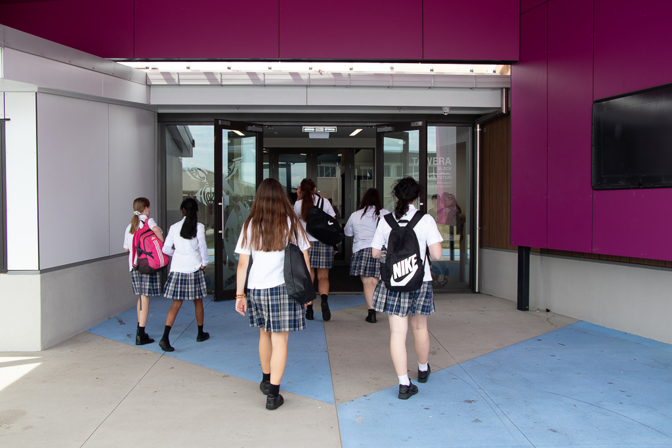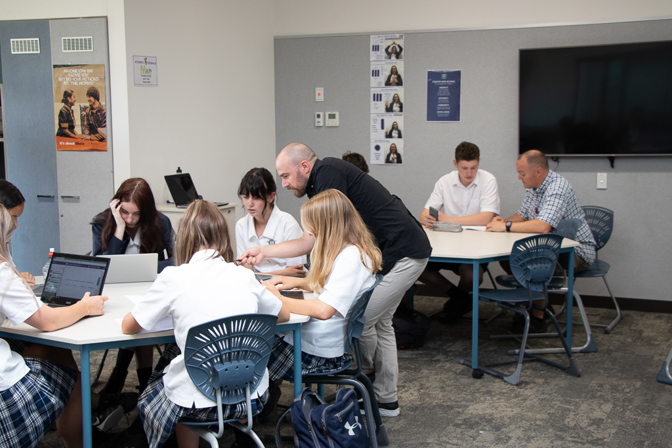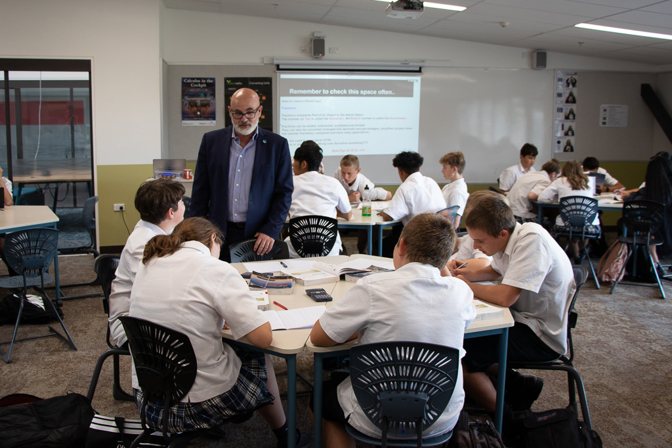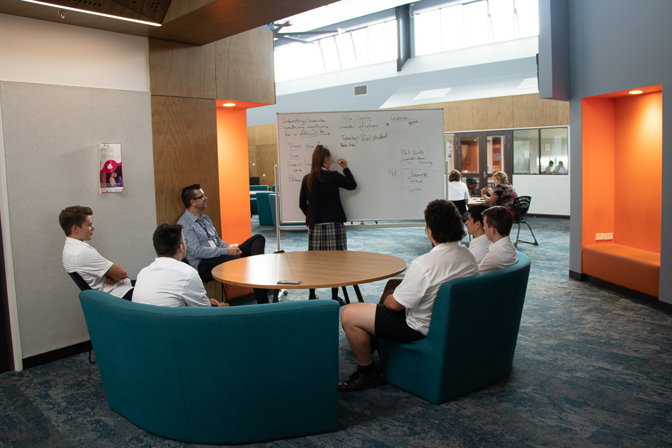Kaiapoi High School – An organic approach to collaborative learning
As it entered a rebuild and redevelopment process post-quake, Kaiapoi High School focused on the key question “What does teaching and learning look like in a new environment for us?” It was of primary importance that the new learning spaces should support modern pedagogies, but it was also essential that the facilities met the needs of the staff who would teach in them.
School leaders also believed it was important that the design be able to meet the needs of future students, both those currently in feeder primary schools, and those who would attend in decades to come. Bruce Kearney, the principal, and Jo Collins, the Leader of Learning on collaboration, spoke about their journey through this process.
Continuation of learning
The school initially looked to its feeder primary schools, many of which were either already teaching collaboratively, or were moving towards more collaborative models of teaching and learning.
Kaiapoi High School wanted to ensure that the types of teaching and learning at feeder primary schools would support effective and seamless transition into secondary school:
“Because it was just not acceptable that they’re doing all this work with their students, and then we were just rewiring them back into a single cell facing the front scenario. So that’s how our journey began.”
However, the school was also mindful that collaborative learning as it occurs in a primary setting would be complex to apply in a secondary setting, as it can be challenging to manage cross-curricular integration. They decided to inform their understandings of collaborative teaching and learning through prototyping with existing buildings.
Challenge One – A problematic prototype
Schools often teach their students not to fear failure, as risk-taking is an essential part of learning and development. This is a far easier lesson to teach than to experience, as school leaders at Kaiapoi High School found at the beginning of their prototyping journey.
A number of teachers took part in a planning committee which resulted in double classroom spaces being created through the removal of walls in existing spaces. Teachers and students were timetabled into these teaching spaces, and it was assumed that they would work together to plan and deliver teaching and learning that best utilised these larger collaborative spaces.
In practice, classes were often ‘co-located’, in which two disparate classes worked in the double space, without collaboration occurring between the two teachers and their students:
“There’s no purpose to it; there are only downsides. It’s the killer of collaborative energy. But when you’ve got limited resources of classes, and those two classes are counted as two classes, you need to use those places.”
In practice, without the opportunity to plan in advance and refine how collaborative pedagogies would operate, teachers found it challenging to adapt to collaborative learning in the prototype spaces:
“We looked at everything, and we came back really excited, and we didn’t really do a lot of the consultation around it … we came up with this wonderful plan that totally fell apart.”
Moving forward, it was essential for teachers to play active roles in the planning and design of the school to best meet their needs as well as the needs of students. While the implementation of the prototype was unsuccessful, it was a valuable iteration to open up new ideas to focus attention on, and refine the concept of collaborative learning.
Challenge Two – The timetable
Teachers of various subjects were brought together to plan how collaborative learning would look and operate. This led to two teachers from different learning areas teaching the same Year 9 class and collaborating on a smaller scale. The school explored expanding this further, but found that it was restricted by the operational realities of timetabling and staffing allocations.
The second lesson learned was that the reality of a school’s operations needed to be given careful consideration as part of any collaboration design process.
The school created two positions for Leaders of Learning. The first was Jo Collins, in a Leader for Learning role that focussed on pedagogy and collaboration. The second position focussed on the operational and infrastructure considerations that would enable Kaiapoi High School to work more collaboratively, such as double length periods.
Jo’s role as the Leader of Learning on collaboration was intended as a two-year role, but the school has now extended that role while the form and function of collaborative teaching and learning continues to evolve and embed.
Challenge Three – The change process
Part of the continuation of the role has been supporting teachers through the change process. As is inherent with changes of this nature, the school found changes to pedagogy and practice sometimes met unexpected challenges or roadblocks.
Training and development for teachers has been an essential part of the change process, particularly for teachers who are used to more traditional pedagogies.
The school addressed the potential resistance to change by allowing collaboration to grow organically:
“We are normally quite social people, and we experience the price of happiness when we have a really good student teacher. Somebody else in the class with us; we can bounce ideas, and take turns. Why not spread that out into something a little bit larger than just a student-teacher, teacher relationship?”
Looking at different options, a majority of teachers were comfortable collaborating within their subjects and enjoyed working with like-minded people. Essentially, the teaching and material is the same, but further opportunities are opened up. This meant teachers weren’t challenged to adapt to both collaboration and cross-curricular integration, but could use the additional knowledge of their colleagues to enhance the teaching in their learning area:
“There are so many opportunities that are opened up in terms of differentiation for your kids, choice for your kids. And the opportunity to have one person taking the bulk of the class, while another brings up the kids who are really struggling, or takes the high flyers and challenges them.”
Open, respectful communication has been key to this process. This has included surveys with students and teachers to determine how well things are working and where improvements can be made.
Teachers outline and negotiate several aspects of the learning environment before teaching collaboratively. This includes the space and seating, workload of planning and teaching, discussion and noise levels, students moving around, lateness, behavioural issues, helping students, timing of negotiations and planning, and non-negotiables/pet peeves. Mediators are also nominated where breakdowns of relationships occur.
“It is all about negotiation in what we really want to say as the people sit there and discuss these things in a communicative manner, rather than festering on it.”
This has helped reduce relationship issues by creating a structure for issues to be quickly identified and resolved.
Collaborative teaching with a 'both/and' mindset
Allowing collaborative learning to develop organically has allowed for threats to be identified, researched, and resolved or mitigated. The issue of co-location is one which is fixed through meaningful collaboration. Where classes are able to work in tandem, co-location is inherent, but collaboration allows it to be a valued learning opportunity. Buildings don’t dictate pedagogy, but they set a strong foundation upon which good pedagogy is enabled:
“Having old, concrete blocks and single cell facilities was not reflective of modern, high quality teaching and learning and effective progressive pedagogies. New facilities needed to be high quality, enable collaborative learning, and meet the needs of learners and staff.”
By allowing collaborative learning to develop organically, it was quickly discovered that imposing a large open learning environment on all teachers disempowered them. This resulted in a redevelopment plan with multiple class sizes - some single cell, and some equipped to take larger classes with 45 or 55 students.
To illustrate the ‘both/and’ approach to teaching and learning, Bruce gave the example of one teacher who was particularly powerful in a single cell environment and who gives a more direct learning experience. This works for them, supports their needs, and also meets students' needs, who enjoy the class and perform well:
“Every single one of those students in their class absolutely loves it to bits. There he connects with them, he teaches them, and they do fantastically well. He’s never going to go into a collaborative teaching environment, and I didn’t put him in one because he is powerful in the environment that he’s in.”
Collaboration has now moved beyond the classroom and is becoming part of the school culture. It’s not just having collaborative classes and pedagogy, but being a collaborative school. Bruce and Jo expect that this will continue to translate to opportunities to share workspaces, knowledge, resources, and support.
Top tips
Build a foundation
Essential to the success of this process was first putting the time and patience into developing a strong collaborative pedagogy that would dictate how the physical spaces would look and work.
If at first you don't succeed, try again
The prototype open learning space with multiple teachers was unsuccessful because the concepts were imposed on students and teachers. The prototype supports the need for a strong foundation before creating large open spaces and expecting everyone to adapt.
The importance of organic growth
Introducing collaborative pedagogy required the concept to be developed organically. Challenges and threats were discovered, researched, and resolved. Having teachers work together was a process where they were empowered to work collaboratively and improve practice in a way that was non-threatening and encouraged risk taking.
The importance of communication
Communication was essential for collaborative learning to be successful. This involved teachers voicing their thoughts, opinions, and objections, and negotiating ways of working together. This helped staff forge relationships and resolve issues so that collaborative learning can enhance teaching and learning experiences for both students and teachers.
Additional resources
Grow Waitaha resource bank
Find resources on collaborative approaches to teaching and learning. Use the filters to refine your search results.
Collaborative teaching and learning
This video collection features students and teachers from Canterbury schools sharing their experiences of collaborative teaching and learning.
Innovative learning environments
This kete contains a range of ideas, strategies, tips and resources for working in innovative learning environments. These are tried and tested in the classroom, as the kete has been developed using information shared by teachers.












